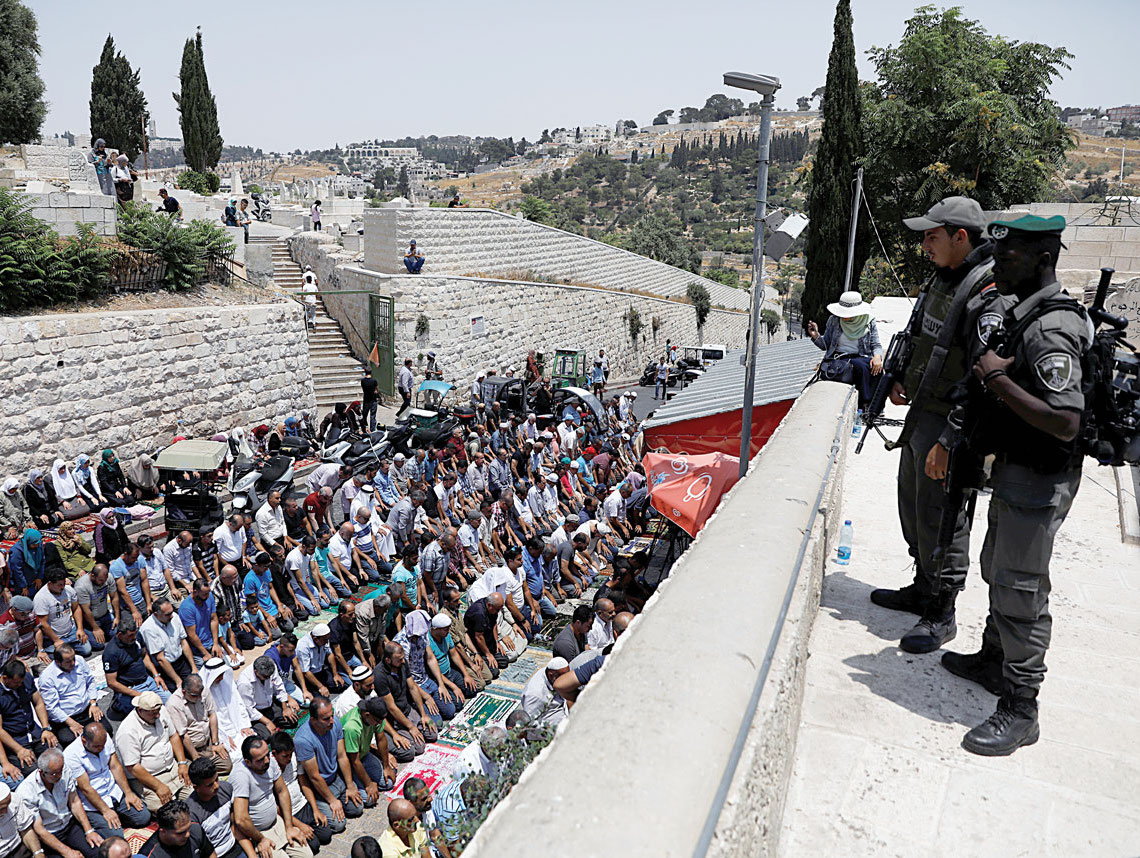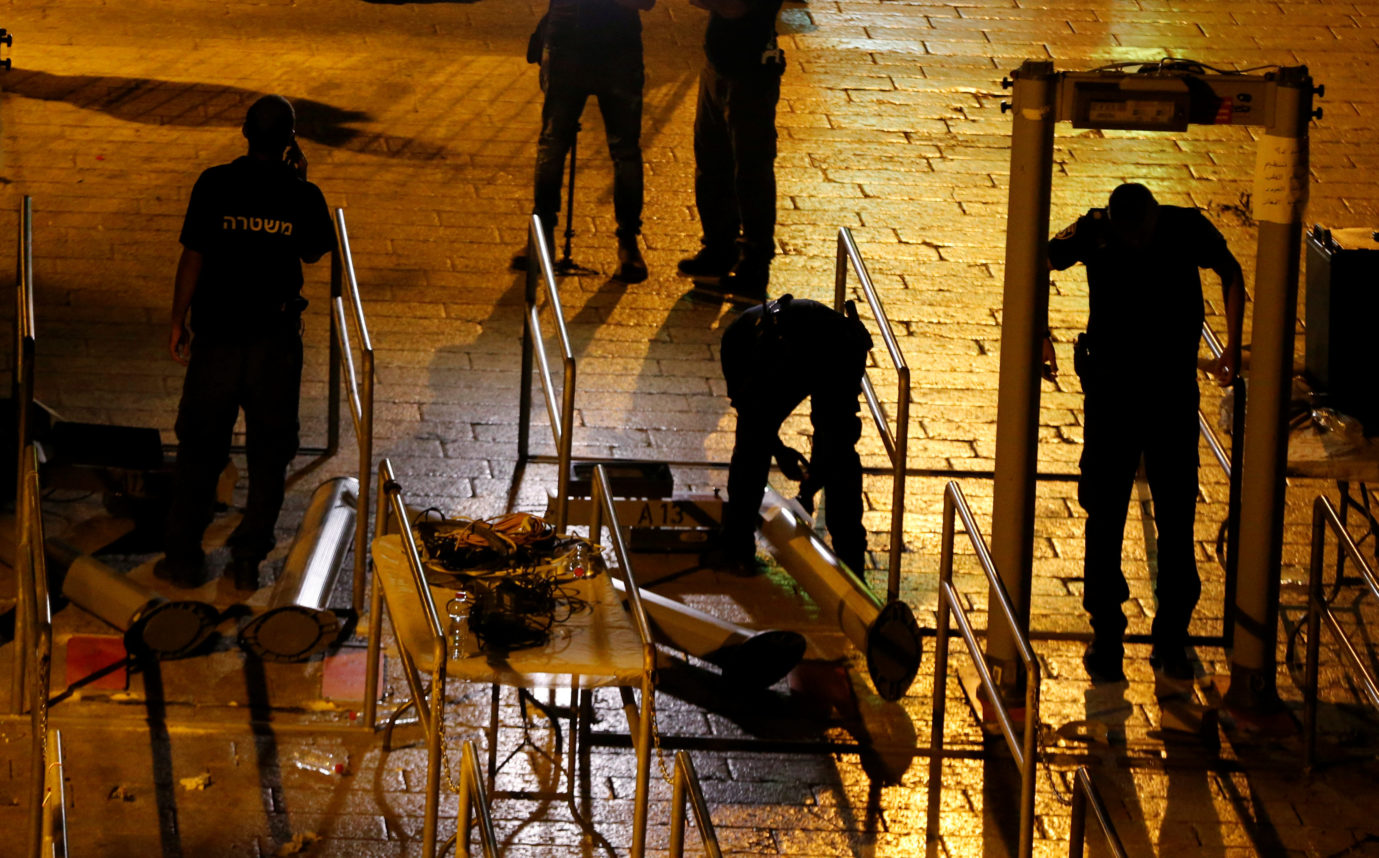 Israeli border police officers stand guard as Palestinians pray at Lion’s Gate, an entrance to Jerusalem’s Old City, in protest over Israel’s new security measures at the compound housing Al-Aqsa Mosque on July 20. Photo by Ronen Zvulun/Reuters
Israeli border police officers stand guard as Palestinians pray at Lion’s Gate, an entrance to Jerusalem’s Old City, in protest over Israel’s new security measures at the compound housing Al-Aqsa Mosque on July 20. Photo by Ronen Zvulun/Reuters The holy site presents authorities with a millennia-old dilemma
For a long-serving prime minister of Israel, a country that rarely rests, everything is deja vu.
A crisis roiling Israel over the past two weeks — one that threatened to explode into a holy war across the region — found its epicenter once again at the Temple Mount in Jerusalem, a site revered equally by Jews and Muslims.
On July 14, two Israeli Arabs shot and killed two Israeli Druze policemen guarding access to the Temple Mount. That led to a temporary closure of the area by Israel, the installation of metal detectors at the entrance and charges of violating the status quo by the Jerusalem Islamic Waqf, the Temple Mount administering authority.
Protests built throughout Jerusalem and the West Bank — joined by international voices of condemnation from the Muslim world. On July 21, three Palestinian protesters were killed in clashes with Israeli security. Later that night, a 19-year-old Palestinian stabbed three Jews to death as they were celebrating Shabbat in a West Bank settlement. In Jordan, a man enraged by Israel’s perceived sins against Al-Aqsa, stabbed an Israeli guard at the Israeli embassy, who shot and killed the attacker. The Jordanian government detained the security guard.
And Benjamin Netanyahu, the long-serving prime minister, found himself yet again trying to prevent isolated acts of violence escalating into all-out war.
A reasonable attempt to change the status quo near the Temple Mount? Bibi has been there — in September of 1996, shortly after he became prime minister, Netanyahu opened the tunnels below the Western Wall.
Riots as a response to this trivial act? Done that — after the opening of the tunnels, and on several other occasions.
An Israeli combatant captured in Jordan? Netanyahu experienced that in 1997, when two Mossad agents attempted to take Hamas’ Khaled Mashaal’s life in Amman. They were arrested by the Jordanians.
An exchange of these combatants in return for Israeli concessions? In 1997, Netanyahu was forced to release the radical leader Ahmad Yassin from jail.
For a long-serving prime minister, climbing off a tree is a routine. Netanyahu has climbed off shrubs, low branches and tall trees. His skin is thick, his ability to flip-flop well-developed, his rhetorical acrobatic skills impressive. His relative calm draws from another frequent deja vu: In two or three days — maybe after Tisha b’Av next week, when Jews around the world begin a day of fasting to remember the destruction of the Temples by the Babylonians and Romans — it will all be forgotten. A new scandal, development or crisis is going to draw away the attention from the embarrassing month Israel just concluded.
On the night of July 24, Jordan agreed to release the Israel security guard who shot and killed the attacker. That same night, Israel announced it would dismantle the metal detectors that were installed near the Temple Mount.
Israel clumsily insisted that these two events were separate, but we all know the truth. A mishap in Jordan provided the prime minister with the ladder he needed. Yes, it is somewhat humiliating to announce with such bravado that the rules are changed — and then cave under the pressure of violent response. But the public is more forgiving when the excuse for caving is the urgent need to save one of our warriors besieged in a foreign country.
As a political event, this was a problematic moment for Netanyahu. He exposed himself to criticism from the left — why did you not think before acting? And from the right — why did you cave under pressure? As a security-related decision, it also was problematic: The decision to change course means that security is not a priority, or that the detectors were never really needed, or that better options were available.
But most of all, this month created an image problem for Israel. It created the impression that the Temple Mount is too sensitive and too explosive for Israel to truly rule it, as it claims to do. It created the impression that violence against Israel changed its leaders’ minds. Both these impressions are dangerous. They are dangerous because they undermine Israel’s claim to the Temple Mount. They are dangerous because caving to violence is an invitation to more violence.
There is no better time than the first nine days of the month of Av to remember that the Temple Mount is a place where violence is a recurring problem. It is a place where plans made by leaders are frequently aborted. It is a place where a clash of religious sentiments is not a rare occurrence.
Jews believe the Temple Mount is the biblical Mount Moriah, where an angel intervened to stop Abraham from following God’s command to slay Abraham’s son Isaac and later became the site of the First and Second Temples until they were destroyed.

In the mid-first century, writing about the Jewish Temple several decades after its destruction, the Jewish historian Josephus seemed to expect that the Temple would be rebuilt. But the Roman general Titus already advanced the idea that the defeat of the Jews was a main justification for his and Vespasian’s seizure of power in Rome. Another Roman, the pagan Julian, planned to rebuild the Temple almost 300 years after its destruction. His plan was designed, it has been said, more to insult the Christians than to please the Jews.
For 1,000 years, a Jewish Temple stood on the Temple Mount. When it was destroyed, the site lay desolate until late into the seventh century, when Muslim caliph Abd al-Malik ibn Marwan constructed a shrine, Dome of the Rock, which still stands. Muslims believe the Temple Mount is where their prophet Muhammad ascended to heaven on his steed Barak.
In 1967, when Israel captured the area, a short term of uncertainty ended with a decision not to rock this religious boat more than it already was shaken. In the government’s archives, there are few letters and documents attesting to this time of uncertainly. In late October 1967, four months after the Six-Day War, a letter to Prime Minister Levi Eshkol from the Waqf, the body in charge of the mosques on the Temple Mount, was distributed among the relevant offices. Jews, the Waqf complains, are entering the Temple Mount to pray and read from the Book of Psalms.
“Jews that are visiting Temple Mount are trying occasionally to do things of this nature, and thus are disrespectful of Muslims’ feelings,” the Waqf warns. The letter includes a reference to the Israel Defense Forces Chief Rabbi at the time, Shlomo Goren. He was one of this group of naughty Jews. It also includes a warning of “unpleasant consequences.” The Israeli government, as the archive testifies, never sent a response to the letter.
“As agreed,” writes Eli Amir, the adviser to Arab affairs in the prime minister’s’s office who became a well-known Israeli novelist, “we did not respond nor confirmed that we received this letter.”
Those were the days when Israel might have had the option to change the status quo on the Temple Mount. The debate as to whether it was a mistake not to take this opportunity, while stimulating, never can be resolved. Maybe the shock of the great victory provided Israel with an opportunity to re-establish a Jewish presence on the holiest center of Jewish civilization. Maybe attempting to use this opportunity would have resulted in disaster.
It is interesting to wonder what the current government would have done had it been in power when Israel captured East Jerusalem. It is interesting to wonder if a government more traditional, more nationalistic, would have made a different call.
The Israeli governments that ruled Israel after 1967 — headed by Eshkol and later Golda Meir — were reluctant to make any decision concerning Jewish presence on the Temple Mount. In many ways, the governments’ discussions back then are reminiscent of those of the current government.
Rather than making a principled decision, the hot potato of the Temple Mount policy was handed to the police. “I suggest we don’t make a formal decision on this matter,” argued Minister Menachem Begin of the Likud Party and a member of the unity coalition of that year. Interior Minister Haim-Moshe Shapira concluded that “on principle, it is permissible [for Jews] to go and pray. Legally, it depends on the police … you [the police] have to carry this burden.” Shlomo Hillel, representing the Foreign Ministry, agreed, suggesting “to define this matter as a matter of the police.”
Well, the police recommended to install metal detectors following the July 14 attack and recommended to uninstall them 10 days later. Relying on the police has the advantage of keeping things vague and pragmatic.
It also has disadvantages. The Temple Mount is not a matter for the police to deal with; it is a matter for the government and for considerations larger than the riot of today or the outcry of tomorrow.
Since 1967, all that Israel achieves in the Temple Mount are small alterations, at times successful, at other times less so. Its recent clumsy move was of the latter type, aimed not at annoying the Muslims, nor at making a dramatic change. Rather, it was a quick response to a dramatic change in the status quo made by three terrorists who used the Temple Mount as a base to attack and kill Israeli policemen.
The response was necessary; Israel cannot accept such actions and not respond. The haste also was understandable. When the government responds to terrorism, it needs to do so quickly, when the blood is still boiling and when the message is still clear.
But the result was not quite what Israel was hoping for. It was also not a complete disaster. Although not Israel’s finest hour, violence was reasonably contained, the outrage was clearly manufactured, the criticism from abroad was tolerable.
Israel caved not because of its inability to withstand the mounting pressure of violence and diplomatic hurdles. It caved because its leaders realized the implications of their actions are unworthy of the trouble. The price was too high compared with the estimated reward.
It remains to be seen if alternatives to the metal detectors — sophisticated cameras and other high-end equipment to be installed over the next six months — won’t ignite the same response and a similar process of trial, error, negotiations and back to Square One.
On July 25, Muslim worshippers were asked by their leaders to stay put and refuse the invitation to go back to business as usual.
The Waqf said it is not going to accept cameras or any other new means.
Israel says it needs them and will install them.
I always prefer to believe my own government more than I believe other nations, organizations and groups. But this month, only a fool would not be cautious.





















 More news and opinions than at a Shabbat dinner, right in your inbox.
More news and opinions than at a Shabbat dinner, right in your inbox.